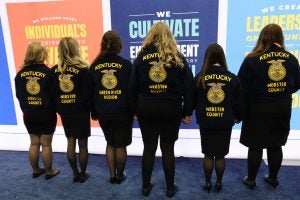The Sweetheart jacket’s white color may initially invoke flashbacks to women’s ancillary membership in the FFA, but the jacket’s distinctive color also offers a conversation piece about decades of division over women’s role in FFA, society, and agriculture.
Founded in 1928, the National FFA Organization wrote the original FFA constitution that read membership was open to “any student of vocational agriculture.” But, in 1930, all of that changed — two years after its founding, delegates at the national convention voted to exclude women.
The 1930 constitution changed to say, “any male student” — something that took the organization 30 years to correct. Massachusetts, however, did not change its constitution and battled the National FFA Constitution over the years to include female membership.

While women may not have been allowed membership in the years soon after 1930, there’s no denying females’ contributions to agriculture and agricultural advancements.
One of the first pioneers of women’s involvement in agricultural education was a woman named Charlotte Ware. Ware started a school in Massachusetts in 1909, training women to be dairy farmers and helping to establish the Norfolk County Agricultural School in Norfolk, Massachusetts.
Another proponent of females in agricultural education was Rufus Stinson — who introduced the idea of experiential learning (now known as Supervised Agricultural Experiences) outside of the classroom to teach and engage students.
In 1937, there was a Constitutional Amendment that said that in states with laws prohibiting discrimination, students could participate at the state level but not the national level. And, women did participate at the state and regional level. According to the National FFA Organization, females participated under the guise of initials on the rosters, and some women attended FFA camps “under cover” as daughters or nieces of advisors.
In 1933, FFA adopted the blue corduroy jacket as a member uniform. Women, however, were excluded from wearing the blue jacket, and between 1949 and 1969 were provided with the token white FFA Sweetheart jacket. Although chapter Sweethearts were not allowed full membership, the FFA Supply Service Catalog offered first a rayon jacket in white or light blue, and then a corduroy version beginning in 1961.

In the 60s, however, everything began to change. Congress passed the Agricultural Education Act of 1963, saying that the purpose of agricultural education is to prepare agriculturalists. Then, in 1964, the Civil Rights Act was also passed by Congress — making FFA’s policy of female exclusion illegal.
One graduate student, Earl Kantner, did a study on how FFA needs to change. Katner surveyed 300 people asking the questions: “Should we allow girls in the FFA?” The principals said yes. Professors said yes. But, ag teachers said no. State supervisors said no. And, FFA executive secretaries said no.
In 1964, the Civil Rights Act was passed by Congress, and the FFA policy of excluding women became illegal. William Metzger, the head lawyer for the Department of Education, told the National FFA that the exclusion of girls in the FFA violated federal law.

This required a change of the constitution: FFA membership voted against extending membership to women in 1967 and again in 1968. In 1969, allowing females into the FFA passed by just two votes, and females were finally allowed into the FFA.
Anita Decker and Patricia Krowicki became the first female FFA delegates in 1970. In 1976, Julie Smiley became the first female national officer, and Jan Eberly became the first female national president in 1982. In 2002, Karlene Lindow was the first female named the American Star Farmer. Bre Holbert became the first female African American president in 2017.
Since the official inclusion of women, the National FFA Organization reports that nearly half of all membership are female. Women continue to blaze the trail as active members, inspiring positive change in the National FFA Organization, agriculture, and beyond.
Heidi Crnkovic, is the Associate Editor for AGDAILY. She is a New Mexico native with deep-seated roots in the Southwest and a passion for all things agriculture.



